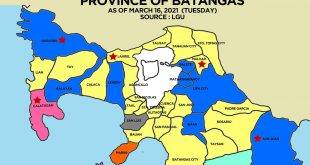Visit the San Luis, Batangas page for all information on San Luis.
What you are about to read is the history of San Luis taken from the existing records of the Municipality of San Luis.
The town of San Luis formerly called “Balibago” was among the southern barangays of old Taal. Accordingly, it was named Balibago because of its proximity to Balibago River which separates San Luis from Taal, and the river was so called because of its ever changing course which is vernacular means “pabago-bago”.
The early inhabitants clamored independence from Taal. The secession movember reached its peak leaving the Municipal Government of Taal no alternative but to divide Taal into three: one division so called San Genaro, now Lemery; the second to be called Balibago, now San Luis, and the third remain Taal. Unfortunately, the agricultural economy to Balibago does not warrant self sufficiency, hence Balibago lost her independent status and once again, in 1904, it was integrated to mother town Taal.
Nourished by string desire and determination, the independent ideals remain among the inhabitants, low economy was never a barrier for them to continue the struggle to regain the lost independence. Pioneered by Aquilino Lasala and Andres Medina, nourished by the brilliance of Justice Ramon Diokno and Atty. Vicente Illustre whose contribution, we people of the present generation ackowledge the inhabitants succeeded in their fight for independence. Hence, in February 2, 1918, the independence of San Luis was regained.
Renaming of the Town
When San Luis became a town in August 25, 1861, the barangay name Balibago remain. However, when February 2, 1918, the town regains its independence from the old town of Taal, it was named San Luis to commemorate the first time of its secession from Taal and become an independent town in August 25, 1861 on the feast day of Saint Louis.
Last Updated: November 14, 2013
 WOWBatangas.com Your Source of Great News and Stories from the Province of Batangas, Philippines
WOWBatangas.com Your Source of Great News and Stories from the Province of Batangas, Philippines



